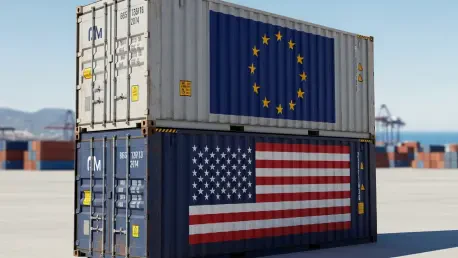American tariff relief on steel and aluminum just met Europe’s most controversial tech rules at the negotiating table, and the stakes landed squarely on factory floors, cloud dashboards, and procurement desks across the Atlantic. The bargaining chip is novel but blunt: scale back pieces of the EU’s digital rulebook affecting U.S. platforms, and Washington will unfreeze a path to a “cool steel and aluminum deal” that could unlock investment and ease rising costs.
The setup reframed an already strained trade corridor. A 50% levy on EU steel and aluminum above tariff-rate quotas, mirrored by EU countermeasures, has spilled into machinery and equipment, tightening delivery windows and compressing margins. Meanwhile, Europe’s push under the DMA, DSA, and the Data Act has imposed new obligations on gatekeepers and data flows, increasing compliance spend for U.S. firms and nudging platforms to recalibrate cross-border services.
Industry Snapshot
Metals and machines sit at the center of the real economy, yet the policy hinge turns on digital rules. U.S. negotiators linked relief on metals to targeted changes in EU tech enforcement, arguing that a friendlier environment for platforms, data movement, and cloud services would catalyze new capex. European officials pushed back on regulatory sovereignty, though internal pressure for industrial relief has grown, particularly from manufacturing-heavy member states.
This cross-sector tactic carries risk. Scope creep from raw metals into downstream categories since the last adjustment widened the blast radius: order backlogs lengthened, logistics buffers swelled, and pricing power shifted unevenly along the value chain. Still, joint meetings between U.S. trade leads and the EU’s digital portfolio signaled a package approach, where narrowly drawn tech tweaks could unlock phased tariff relief without gutting the broader regulatory project.
Market Dynamics And Outlook
The numbers frame a simple calculus. Above-quota shipments face a 50% surcharge; matching EU measures increase incidence for American exporters, with monthly quota utilization now a leading indicator for price swings. Machinery makers reported delivery delays and sporadic cancellations as suppliers rerouted volumes to stay within caps, while cost pass-through to end users varied by contract structure and lead time.
Three paths now define planning: best case, a phased drawdown of metals surcharges tied to targeted adjustments in gatekeeper obligations and data-transfer friction; baseline, limited tariff relief with continued spillovers into downstream components; worst case, stalemate and broader tariffs ensnaring autos, electronics, or cloud procurement. In the near term, trade flows likely tracked quota cycles, prices stayed volatile but mean-reverted on soft demand, and capex favored maintenance and compliance automation over expansion.
Policy And Compliance Lens
Under Europe’s DMA and DSA, large platforms face interoperability, data access, and content oversight duties; the Data Act adds rules on business-to-business data sharing and portability. U.S. concerns center on how these requirements affect commercial flexibility and market access for major American tech firms. On metals, Washington relies on tariff-rate quotas, surcharges, monitoring, and enforcement, while Brussels retains safeguard tools and targeted countermeasures that can touch downstream goods.
For companies, the operational play became twofold: optimize sourcing to stay within quotas and deploy compliance tech to meet evolving platform obligations. Security and governance teams recalibrated data flows, vendor contracts, and cloud locations to hedge against enforcement shifts. Any regulatory recalibration would ripple into procurement terms, platform design, and pricing models, with performance-based triggers or time-limited waivers serving as workable release valves.
Strategic Risks And Signals
The core trade-off pitted EU regulatory sovereignty against near-term industrial relief. Legal constraints, including WTO considerations and domestic politics on both sides, limited how far a package could go without formal review. At the same time, escalation risk loomed: drag the dispute into autos or electronics and supply chain contagion could outpace any political gain.
Executives watched early markers: quota drawdowns by month and product category, DMA/DSA enforcement steps, and the cadence of joint trade–digital talks. External variables mattered too. Global steel overcapacity, energy prices, and China’s export behavior shaped baseline pricing, while election cycles influenced negotiating windows and the appetite for symbolic wins over structural compromises.
What Comes Next
A pragmatic route favored carve-outs for sensitive tech provisions, time-bound waivers tied to measurable outcomes, and sectoral MOUs that align metals relief with narrow, verifiable adjustments in platform obligations or data-transfer frictions. Green steel incentives, transatlantic data frameworks, and supply chain digitization offered upside, especially if compliance interoperability reduced overhead for mid-market exporters.
For firms, the playbook was clear: diversify inputs and lanes, hedge tariff exposure, invest in compliance automation, and model scenarios against widening tariff coverage. Investors prioritized signals of de-escalation, sector carve-outs, and low-carbon metals projects, positioning for a rebound in machinery orders and steadier logistics once quotas and rules aligned more predictably.
Closing Assessment
The linkage strategy had reset negotiations, sharpened cost pressures, and forced a choice between regulatory purity and industrial relief. A sequenced, performance-based package with verification and sunset clauses likely offered the only credible bridge, balancing digital policy goals with the urgent need to stabilize metals flows and unlock investment.









